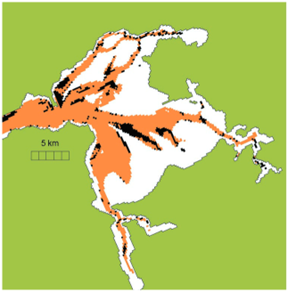The physics of sedimentation would predict that silt suspended on an outgoing ebb tide might settle in Wellfleet Harbor. Two scientific articles support that prediction: The first article above discusses the flow of fine sediment downstream:
- "When sediment-laden floodwaters enter an estuary the finer particles that stay in suspension may be flushed out to sea quite quickly. But heavier particles sink to the bottom as the flow meets salt water. This is why sediment deposition is greatest near the upper reaches of an estuary."
The article presents a simulation model of the tidal channels of a New Zealand harbor (pictured below) in which most of the sediment flow is ebb-tide dominant, while only a small fraction is flood-tide dominant. The brown color in the image indicates ebb-tide dominance, while the black indicates flood-tide dominance. White areas are intertidal sandbanks. The model shows that there was net seaward transport almost everywhere except in the short side arms of main channels.


Sediment transported down the Rhone River into Lake Geneva
(Photo Credit: Rama, 2007, via Wikimedia)
These scientific articles make it clear that silt flows downstream on ebb tides, justifying concerns that this phenomenon could threaten shellfish beds in Wellfleet Harbor when tidal flows are restored to the Herring River.
Return to Sedimentation studies
Return to Flood dominant?
Return to Editorial
Return to Oysters & Silt
Top of page